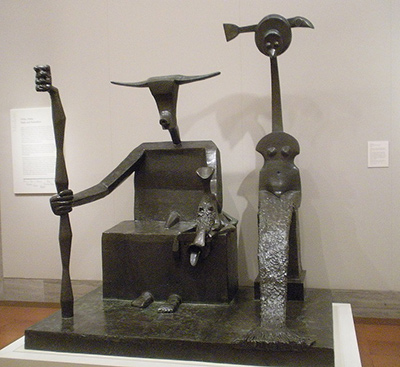Capricorn was a highly significant artwork within the career of Max Ernst, be it, as it was, the most famous sculpture that he ever produced. It is dated at 1947-1948 with many alterations and developments occurring afterwards into the 1960s.
This design was originally produced in 1947, from a combination of cement and iron before a series of bronze versions were cast in both 1964 and then later in 1975. It is entirely normal for sculptures to be re-cast and a similar scenario can be found in the careers of many other notable sculptors from the 20th century. Auguste Rodin, for example, has had many of his moulds used after his death, essentially extending his career beyond his own lifetime. It is an effective way for the museum set up in his name to continue to remain profitable but such pieces will never hold quite the same value as items produced directly from the artist's own hands. An interesting aspect to this piece's lifetime is that it was positioned outside the artist's house in Sedona, looking out menacingly over any potential threats.
"...In the summer of 1947, Max Ernst, exuberant and inspired by the arrival of water piped to our house (up to then we had hauled it from a well five miles away), began playing with cement and scrap iron with assists from box tops, eggshells, car springs, milk cartons and other detritus. The result: Capricorn, a monumental sculpture of regal but benign deities that consecrated our ‘garden' and watched over its inhabitants..."
Dorothea Tanning
In terms of specific casts, there were six made in bronze in 1964, and two further ones made in 1975 - one of those remains in the collection of the National Gallery of Art in Washington DC, which allows Max Ernst's sculptures to retain a prominent position in the public eye and remind many of his work within this medium. There has also been a sculpture garden set up at this institution which displays work from some of the finest modern sculptors from around the world and adds a significant element to the already impressive gallery. The early preparation involved Ernst sticking all manner of everyday items together in order to create form, whilst working out the precise composition of this multi-figure statue.
There are two figures within Capricorn, a horned male and a mermaid. The pose is essentially a king and queen seated on their thrones. There has been some suggestions that the artist claimed this to be a family portrait, but others have cast doubt on this claim. There is also a small animal placed on the king's lap, which might have been a reference to one of the artist's own dogs, but again, that has never been confirmed. Max Ernst was someone who did not desire to tell us every last detail about his works, explaining the meaning of each item. In fact, he liked to leave a little room for discussion, even confusion, and so this is entirely what happened with this particular sculpture. Some have pointed to the fact that neither figure looks overly grand, this is not an entirely respectful portrait, but focuses more on fun.
The National Gallery of Art in Washington DC, USA hosts this sculpture, but it is not always on display so check ahead if you are looking to view this piece specifically. This institution also holds a further five items from Max Ernst's career including several drawings as well as a painting titled A Moment of Calm from 1939. It is important to remember that this artist actually gained American citizenship and so holds a strong connection to the country which continues today through his presence within this exceptional art gallery. Some of the other exciting items to be found here include Raphael's Alba Madonna, Titian's Venus with a Mirror and Jan van Eyck's Annunciation, as well as a new sculpture garden, which itself includes several Joan Miro sculptures and also further pieces from Louise Bourgeois, Roy Lichtenstein and Ellsworth Kelly.




